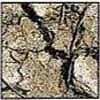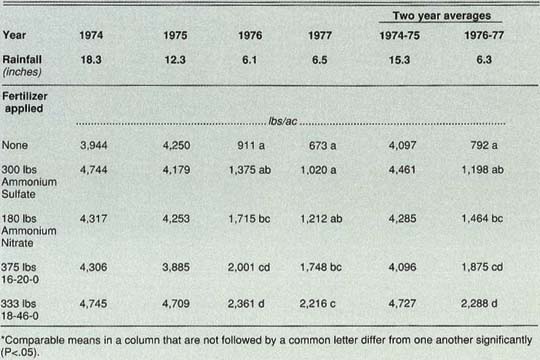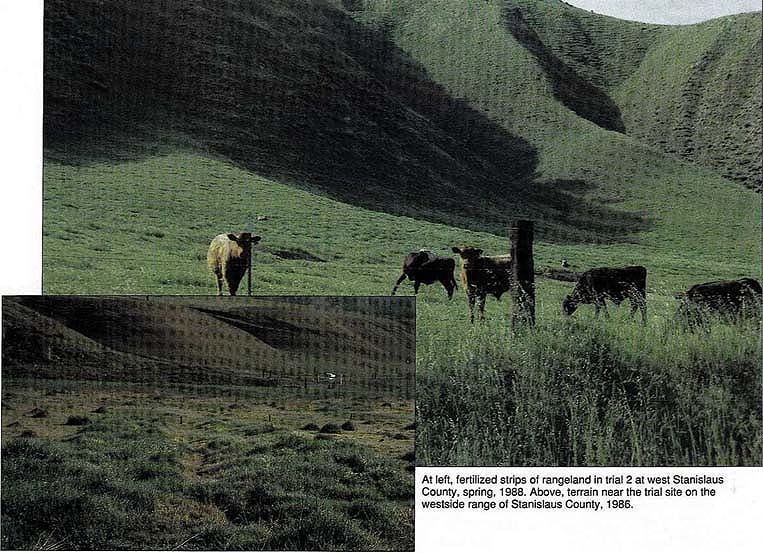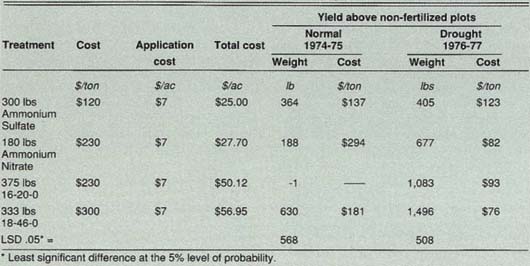All Issues
Fertilizers produce more range forage in drought than normal years
Publication Information
California Agriculture 45(3):28-30.
Published May 01, 1991
PDF | Citation | Permissions
Abstract
Nitrogenous fertilizers produced greater yield increases in drought years than in more abundant rainfall years. None the less, ranchers will need to carefully compare the costs of this added production with other alternatives, and also consider the odds of receiving less than 11 inches of rainfall.
Full text
Two fertilization trials in Stanislaus County led to greater increases in annual range forage yield during drought years than in more normal rainfall years. The first trial was conducted in eastern Stanislaus County from autumn of 1973 to summer of 1977, during two normal years and two well known drought years, the latter spanning the 1975-76 and 1976-77 range-growing seasons. The second trial in western Stanislaus County began in the autumn of 1985 and included the 1985-86 abundant rainfall year and the four drought years of 1986-87 through 1989-90.
Trial 1
This 4-year field experiment on a ranch in the lower Sierra foothills compared four fertilizer sources, all providing 60 pounds of nitrogen per acre, and a nonfertilized control (table 1). In all there were 30 field plots encompassing 6 replications of the 5 treatments. Plots were 1,000 square feet in size and fertilizers were applied in October of each year beginning in 1973. A 250-square-foot area in each plot was clipped in February and again at peak standing crop in May of 1974 and 1975, and the two clippings totalled. Because low winter rainfall prevented winter growth in 1976 and 1977, the plots were clipped only in April. Forage was weighed and oven-dry weights obtained. The soil at the experimental site was a Ryer clay with a pH of 5.5 and a phosphorus level of 3.6 parts per million.
The 90-year average rainfall near the site was 14.6 inches. There were no significant yield differences in the first 2 years of the trial which averaged 15.27 inches of rainfall. Significant yield increases occurred from all fertilizers used during the drought years of 1976 and 1977, which averaged 6.26 inches of rain. These yields varied from 151.1% to 288.9% of the yields obtained without fertilization, although all yields were considerably below those obtained in years of higher rainfall.
TABLE 1. Range forage yields per acre from fertilizer applications In two normal precipitation years and two drought years; oven dry weights (lbs), trial 1, east Stanislaus rangeland*
At left, fertilized strips of rangeland in trial 2 at west Stanislaus County, spring, 1983, Above, terrain near the trial site on the west side range of Stanislaus County, 1986.
Economic analysis (table 2) determined that the costs per pound of additional forage produced from fertilizer were less in the drought years of 1976 and 1977 than in the more normal rainfall years of 1974 and 1975. Using 1990 fertilizer prices, the cost of additional forage produced varied from $76 to $123 per ton in the drought years. During the normal rainfall years of 1974 and 1975, fertilizer costs varied from $137 for each ton of additional forage produced to $50.12 per acre for fertilizer which produced no additional forage, and in fact resulted in a non-significant one-pound decrease in yield. The latter result occurred in plots treated with fertilizer containing 16% nitrogen and 20% phosphorus. The most cost-effective yield increases during the drought years were produced with 18% nitrogen and 46% phosphorus fertilizer applied at a rate of 333 pounds per acre for a cost of $76 per ton.
TABLE 2. Economic analysis of fertilizing in two drought years and two shown in trial 1 of east Stanislaus rangeland
Trial 2
The second trial, begun in October 1985, was a long-term field experiment to determine the optimum annual rate of nitrogen fertilization on annual grassland in the Coast Range of western Stanislaus County. A 3% sloping site received 0,30, 60,90, and 120 pounds of nitrogen per acre applied as ammonium sulfate each autumn beginning October 30,1985. Plots were moved to adjacent locations at the experimental site each October to avoid the possibility of year-to-year soil nitrogen carryover affecting response to current year nitrogen applications. Total annual yields were obtained by clipping at peak standing crop in April of each year. Clipped samples were oven-dried. The soil was a Zacharias Adjunct fine loamy clay with a 6.6 pH and 13.3 parts per million phosphorus.
TABLE 3. Range forage yield according to rate of nitrogen application In a normal year and four drought years, trial 2, west Stanislaus rangeland
TABLE 4. Economic analysis of fertilizing in an above average precipitation year and four below average (drought) years, land, trial 2
The long-term average precipitation near this site is 10.9 inches. There were no significant increases in total annual yields in the first year of the trial when annual rainfall was 16.35 inches (table 3). However, in each of the 4 years from 1987 to 1990, generally declared to be drought years, yields increased significantly at peak standing crop due to increasing rates of nitrogen application. The 0-, 30- and 60-pound rates did not result in significantly increased yields, but the 90- and 120-pound rates of application produced 2,151 and 2,451 pounds more forage per acre than did the non-fertilized check. Those increases amounted to 203% and 217% greater yields, respectively.
As in trial 1, the cost to produce additional forage from fertilizer was less in drought years than in the more abundant rainfall year (table 4). In 1986, costs per additional pound of forage decreased as rate of nitrogen application increased. These costs went from $105 to $1,778 per ton. The costs of additional forage in the four drought years ranged from $32 to $43 per ton. The 90 pounds per acre of nitrogen was most cost-effective during the drought years at $32 per ton of added forage.
In trial 2, the second-year nitrogen carryover was measured only in the years when visible differences could be seen among treatments. Such visible differences were seen and clipped only in February 1988 and April 1990. Because data were not obtained for every year of the trial, the carryover data are not included in this report.
Summary and discussion
In both trials, fertilizers produced more range forage in drought years, averaging 6.26 and 8.2 inches of precipitation, than in years averaging 15.27 and 16.35 inches, respectively. The drought year forage increases were greater and were produced at less cost than in higher rainfall years. Had all the second-year carryover data been obtained, these results would likely be accentuated because the visible differences were seen after the drier years. We may presume that with low rainfall and low plant growth, greater amounts of fertilizer remained in the soil for second-year growth.
The results also suggest that fertilizer applied at these rates in a drought year would not contribute significant amounts of nitrogen to ground water through leaching. Range soils are often shallow with impervious layers, and leaching may not occur. However, high levels of nitrogen applied in a year of abundant rainfall might leach nitrogen downward, affecting ground water quality. At present, there is no definitive data to support either conclusion.
We did not calculate income in these trials; instead, we calculated the costs of added forage from the nitrogenous fertilizer. The costs to produce additional forage can be compared with other alternatives a livestock producer might have available in a drought situation, such as purchasing supplemental hay or other feed, renting additional pasture, or reducing livestock numbers. The value of the forage produced in a drought year is greater than that of forage produced in a normal year due to the comparative scarcity of forage in the drought year.
The nitrogenous fertilizers resulted in less costly forage increases in drought years. Costs ranged from $32 per ton of forage produced with applications of 450 pounds of ammonium sulfate per acre in trial 2, to $123 per ton of forage produced with applications of 300 pounds of ammonium sulfate per acre in trial 1. Even so, such costs may well be in excess of the cost of renting other rangeland. Hay could likely be purchased within this range of costs.
Therefore, even though these trials exhibit data that show nitrogenous fertilizers can produce a greater percentage increase in range forage in years with less than 11 inches of rainfall, livestock producers will always need to consider the odds of receiving less than 11 inches of rainfall, the costs of alternative feed sources, and the costs of the fertilizer and its application.










